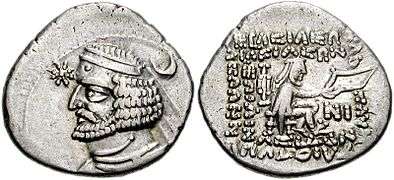Orodes II of Parthia
| Orodes II of Parthia | |
|---|---|
| "King of kings of Iran" | |
 Coin of Orodes II. | |
| Reign | 57–37 BC |
| Predecessor | Phraates III |
| Successor | Phraates IV |
| Born | Unknown |
| Died | 37 BC |
| Issue |
Pacorus I Phraates IV |
| Dynasty | Arsacid dynasty |
| Father | Phraates III |
| Religion | Zoroastrianism |
Orodes II of Parthia (Persian: ارد دوم), (also called Hyrodes Anaridius) was the king of the Parthian Empire from 57 BC to 37 BC. Orodes was a son of Phraates III, whom he murdered in 57 BC, assisted by his brother Mithridates. He married a Greek Princess from the Kingdom of Commagene, called Laodice who was a daughter of King Antiochus I Theos of Commagene and Queen Isias Philostorgos of Commagene.
Struggle for supremacy
Orodes' brother Mithridates was made king of Media; but, soon afterwards, Mithridates was disposed by Orodes and forced to flee to Syria. Mithridates then returned to invade the Parthia, restoring his reign as king briefly in 55 BC. However, king Mithridates was besieged by Orodes' general, Surena, in Seleucia on the Tigris: after a prolonged resistance, Mithridates was captured and slain.[1]
First war against the Romans
Meanwhile, the Roman general and triumvir Marcus Licinius Crassus had made an attempt to extend his share of Roman territory by eastward conquest, and in the event had been decisively defeated and killed in 53 BC, in the Battle of Carrhae, along with his son and with the loss of most of his army, by Orodes' general Surena. Orodes himself had invaded Armenia and forced King Artavasdes, the son of Tigranes the Great to submit and abandon his alliance with the Romans. The victory at Carrhae secured for the Parthians the countries east of the Euphrates. Then, the next year they invaded Syria, but with little success, for Surena, whose achievements had made him too dangerous, was killed by Orodes.[2]
Parthian dynastic war
Some time later, when the Roman consul Marcus Calpurnius Bibulus was appointed the governor of Syria, tried to incite the Parthians against each other; he had close friendship with a Parthian satrap who harbored a grudge against Orodes II, and made him crown the young Pacorus as rival-king of the Parthian Empire and made a campaign against Orodes. Even coins with the portrait of Pacorus were briefly minted. However, Orodes II and his son reconciled to each other and coins with the portrait of Pacorus were stopped minting. The Parthian satrap who was behind the plot was probably shortly executed.
Second war against the Romans
During the Roman Republican civil wars the Parthians sided first with Pompey and then with Brutus and Cassius, but took no action until 40 BC, when Pacorus, assisted by the Roman deserter Quintus Labienus conquered a great part of Syria and Asia Minor. In Judea, the Parthian commander Barzapharnes deposed king Hyrcanus II and appointed the latter's nephew Antigonus as king in his place.
During this period, the Parthians restored their territory to nearly the limits of the old Achaemenid Empire and controlled all of Asia Minor except for a few cities but the Parthian successes were not long-lasting. In 39 BC, a Roman counterattack under Ventidius in Asia Minor defeated Labienus, who was subsequently captured and executed. Orodes' son Pacorus was himself later killed by Ventidius in 38 BC. Orodes, who was deeply afflicted by the death of his gallant son, appointed his son Phraates IV successor, but was soon afterwards killed by him. Plutarch relates that Orodes understood Greek very well. After the death of Crassus the Bacchae of Euripides was presented at Artavasdes' court, with the head of Crassus himself allegedly being used as an accessory for a scene actually including a severed head, on the order of the king.
References
- ↑ Bivar 1983, p. 49.
- ↑ Schippmann 1987, p. 528.
Sources
- Toumanoff, Cyril (1986). "Arsacids". Encyclopaedia Iranica, Vol. II, Fasc. 5. Cyril Toumanoff. pp. 525–546.
- Bivar, A. D. H. (1983), "The Political History of Iran under the Arsacids", in Yarshater, Ehsan, Cambridge History of Iran, 3.1, London: Cambridge UP, pp. 21–100
- Schippmann, K. (1987), "Arsacid ii: The Arsacid Dynasty", Encyclopaedia Iranica, 2, New York: Routledge & Kegan Paul, pp. 525–536
- Plutarch, Dio Cassius
 This article incorporates text from a publication now in the public domain: Chisholm, Hugh, ed. (1911). "article name needed". Encyclopædia Britannica (11th ed.). Cambridge University Press.
This article incorporates text from a publication now in the public domain: Chisholm, Hugh, ed. (1911). "article name needed". Encyclopædia Britannica (11th ed.). Cambridge University Press.
| Orodes II of Parthia Born: Unknown Died: 37 BC | ||
| Preceded by Phraates III |
Great King (Shah) of Parthia 57–37 BC |
Succeeded by Phraates IV |